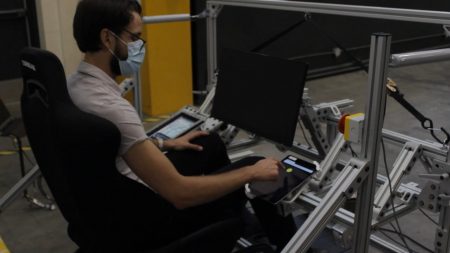
Montréal, international researchers design aircraft flight deck
Maryam Farag
Industry MRO Aerospace aerospace Canada manufacturer manufacturing Technology
Photo: Mitacs.
Relying on video calls and other advanced technology tools, over 1,000 students from 12 countries are working on research at 54 Canadian universities through an internship program called Mitacs Globalink.
One of those students is an engineering researcher from France who is helping a Polytechnique Montréal lab to design a flight deck, creating a cockpit touchscreen that is easier and safer for aircraft pilots to use.
Arthur Camille Bevier, 23, is a Master’s student at Université Paris-Seine, and is working remotely from home under the guidance of Assistant Professor Philippe Doyon-Poulin at Polytechnique Montréal. Bevier is working to understand the issues pilots face as they attempt to enter flight information and other mission-critical data on a touchscreen during flight, and to come up with a design that is better suited to aviation.
“Manufacturers want to bring the efficiency of touchscreens to the cockpit, but as they start to do so, they are encountering problems related to turbulence and vibration, as well as user discomfort,” said Doyon-Poulin. “Pilots have the added complication of trying to do it with their arm fully extended and nowhere to rest their wrist, and they can’t afford to make mistakes,” he added.
Working in collaboration with industrial partner CMC Electronics of Montreal, Bevier’s research builds on a project started by former Mitacs intern Adam Schachner, who designed a test area in the university’s lab that uses an immersive 4D seat to mimic the vibration of an aircraft. After consulting with CMC Electronics engineers to gain a better understanding of the constraints facing pilots when using touchscreens, Bevier analyzed over 75,000 data points collected by Schachner from 23 participants who were asked to perform various touchscreen tasks under specific vibration conditions while seated in the lab’s test area.
“My goal was to think like a pilot and by doing so, to find a keyboard layout and user interface that would be more suitable for use during flight,” said Bevier. “Right now my focus is on text entry so that when a pilot needs to change their heading or altitude, adjust the radio or change their route, they can be confident they’ll make the right selection.”
The team’s early research indicates that the overall error rate of cockpit touchscreens is 13 per cent on average, but can rise to 20 per cent as vibrations from turbulence worsen and up to 40 per cent as buttons or widgets on the screen get smaller. Their next step is to test all three prototypes designed by Bevier in the lab to compare results and establish which is most stable for use in flight. Once published, they will pass their findings on to CMC Electronics to improve future avionics designs.
